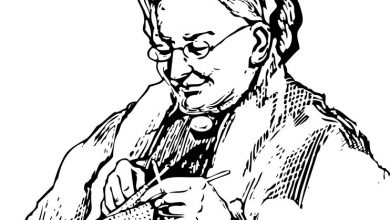Nabokov’s short story, “Signs and Symbols” was initially published in the New Yorker in 1948, the narrative revolves around an elderly married Russian couple who have immigrated to the United States. Their son is afflicted with paranoid delusions and is currently undergoing treatment in a sanatorium. The story primarily centers on their unsuccessful endeavor to visit their son and the consequences that ensue.
Vladimir Nabokov Russian-American novelist and poet, had a multilingual upbringing and was fluent in Russian, English, and French. His notable works include Lolita, Pale Fire, Pnin, Ada, and Ardor: A Family Chronicle, among others.
Signs and Symbols | Summary
The story follows a Russian immigrant couple in the United States as they set out to visit their son in a sanatorium on his birthday. Their visit encounters a series of challenges. First, they struggle to find an appropriate gift and ultimately settle on a basket of fruit jellies. During their journey, the subway halts between stations, causing a delay. Additionally, the bus they take is late and filled with noisy schoolchildren.
When they finally reach the sanatorium, they learn that their son has made another suicide attempt due to his ongoing struggle with a mental illness known as ‘referential mania.’ This condition leads him to believe that everything in the world is connected to him in some hidden way. The sanatorium staff advises against disturbing him further, so the couple is unable to meet their son. On their way back home, the wife reflects on her son’s condition and the challenges they face as a family dealing with his mental health issues.
As they journey back home, the wife becomes engrossed in her son’s mental state, finding signs and messages about him even in the clouds and shop window displays.
Upon reaching home, the wife decides to buy fish for supper and sends her husband ahead while she goes to make the purchase. However, he realizes he has already given her the keys earlier, so he waits outside in the thunder and rain until she returns. Once inside, the husband takes out his dental plate and settles down to read the newspaper.
Later that night, after the husband has gone to bed, the wife stays up and delves into old photograph albums filled with pictures of their son from their time in Europe before immigrating to the United States.
From a young age, their son’s referential mania becomes apparent when he displays fear of seemingly innocent things like the wallpaper in their house’s hallway and an idyllic picture in a book, convinced that they hold hidden messages about him.
After midnight, the husband enters the room expressing his insomnia, and requests some tea. He urgently suggests taking their son back from the sanatorium to prevent any further self-harm attempts. They decide to bring him home the next day and ensure all potentially harmful objects, like knives, are kept out of his reach. While they sit awake, the phone rings multiple times, and a girl inquires about someone named ‘Charlie.’ The wife politely informs her about dialing the wrong number by confusing the letter “o” with zero.
As the husband sips his tea, he admires the jars of jelly they had purchased for their son’s birthday, silently spelling out the labels with his lips. In the midst of this, the telephone rings again.
Signs and Symbols | Analysis
The story unfolds in a vast American city during 1947 or 1948, encompassing the apartment of an elderly couple, various public transit systems, city streets, and a mental hospital. Throughout the narrative, the atmosphere remains bleak and cheerless, mirroring the somber weather and the desolate scenes witnessed by the elderly couple.
‘Signs and Symbols’ by Nabokov is a tale immersed in ambiguity and uncertainty. The very title holds multiple interpretations, ranging from the son’s belief in hidden ‘signs and symbols’ within nature to the playing cards’ symbolic significance, and the mother’s perception of her son’s illness in old photographs. Nabokov cleverly weaves various images, signs, and symbols throughout the story, sometimes subtly, seemingly casual or insignificant details.
The final telephone call exemplifies Nabokov’s playful approach to the very essence of ‘signs and symbols’ that writers employ to create or imply meaning. One may assume that the girl calling back for ‘Charlie’ made the third call, but the story prompts contemplation of alternative possibilities. It could also be the sanatorium delivering tragic news about their son, or perhaps, it is the son himself, reaching out to his concerned parents after escaping from the sanatorium. The story leaves readers questioning the boundaries of interpretation and meaning, adding to its enigmatic allure.
The deliberate ambiguity in ‘Signs and Symbols’ serves as a lure, enticing readers into the trap of deciphering the hidden ‘clues’ to construct a narrative. We find ourselves trying to determine whether the son has passed away, escaped, or if the status quo remains unchanged.
In this process, we, as readers, become akin to the son, trapped in our referential mania, desperately seeking significance in the provided details and attempting to conclude. However, such an endeavor might prove futile because Nabokov’s ‘signs and symbols may, in reality, be just the ordinary signs and symbols we encounter daily – coincidental, commonplace, and unremarkable. The story challenges us to question the nature of interpretation and meaning, subtly reminding us of the complexities of perception and the elusiveness of certainty.
While ‘Signs and Symbols’ maintains deliberate ambiguity, some of the images and details provided by Nabokov do carry meaningful significance. In certain instances, the imagery becomes clear and evocative. For example, the sight of a ‘half-dead unfledged bird’ twitching in a puddle, witnessed by the couple on their way home, holds deep symbolism. This scene not only reflects the father’s nervous ‘twitching’ hands but also serves as an evident representation of their son. The son, grappling with his attempt to end his life and losing control of his mind, is metaphorically ‘half-dead’ and ‘unfledged,’ unable to escape his situation fully. The wife later recalls an incident at the sanatorium when their son tried to flee, and another patient mistook his actions as an attempt to ‘learn to fly.’ These vivid and poignant images enrich the narrative with layers of meaning, even amidst the overarching ambiguity.
Within the two narrators of the story, a profound existential crisis emerges, reflecting a universal human experience. Nabokov skillfully amplifies the mundane aspects of life through extreme circumstances. The son embodies our inherent need to comprehend and make sense of the world around us. Each individual perceives the universe through their unique filters, an unavoidable form of mini-narcissism inherent in all of humanity. As a result, we can never be entirely objective in our perceptions since they are inevitably shaped by our senses and minds.
Throughout life, we unconsciously relate to people, objects, and sounds based on our internal understanding of the world. Just like the elderly mother in the story, we might encounter events like a dying bird or a late bus and contemplate whether they hold some special significance or sign. Alternatively, we could interpret entirely different meanings from other observations.
Unlike the son, who is trapped in “referential mania,” we can regulate our filters and find meaning in life, enabling us to maintain sanity as we navigate through it. Despite the son’s intellectual capabilities, he is powerless to control the overwhelming barrage of signs that he perceives, underscoring our capacity to find balance and stability in the face of life’s complexities.
The story also delves into another dual aspect – the parents’ internal struggle to come to terms with their role in their son’s insanity. This struggle is evident in the mother’s contemplation of old photographs, reminiscing about their past life in Russia, and hints of escaping from Nazi suppression. She perceives the unfairness of her son’s deteriorating condition and the helplessness of relying on relatives for financial support. Her hope lies in the possibility of bringing him home from the sanitarium to care for him themselves. These emotions and thoughts continue to simmer and intertwine, each moment reinforcing either positive or negative sentiments.
Amid this delicate balance of redemption or ruin, the elderly couple receives three phone calls in the middle of the night. As readers, we are drawn into their emotions – the dread of hearing the phone ring, the uncertainty of answering it, and the relief and euphoria when it turns out to be a wrong number, not once but twice. However, as the phone rings again, the atmosphere takes a tense turn.
Amidst this scene, the husband takes pleasure in examining the colorful little jars of fruit, and he spells out their labels with clumsy, moist lips. This seemingly ordinary moment contrasts sharply with the looming tension of the ringing phone, leaving readers anxious about what might unfold next. The story brilliantly captures the complexity of emotions and the human psyche, compelling us to navigate the fragile balance between hope and despair.
The story concludes abruptly, leaving the fate of the third phone call ambiguous. However, the lack of closure is intentional, as the real journey lies in the emotional and psychological turmoil the couple has already experienced. Whether the call is another wrong number or the sanitarium delivering tragic news, it becomes irrelevant in the grander scheme.
The couple has already filtered the signs, and their reality is shaped by the potential outcomes. If the son is dead, there might be a mix of relief and grief as it would mean an end to the sanitarium and worries, but it would also break the couple’s spirit. On the other hand, if the son is alive and brought home, it would result in constant stress and worry, leading to a different kind of grief.
Ultimately, both scenarios share the same emotions – stress, worry, grief, and relief – regardless of the outcome. The story highlights that the perceived signs and symbols all point to the same place, emphasizing the power of individual perception and the inherent complexities of human experience. The open-ended conclusion allows readers to contemplate the broader themes and implications of the story, leaving a lasting impact on their minds.
Signs and Symbols | Themes
In the short story “Signs & Symbols,” Nabokov skillfully employs the concepts of ‘madness’ and ‘insanity’ to drive the conflict and blur the line between reality and delusion. He presents a different perspective on insanity, not merely as a portrayal of an unsettling reality, but also as a critique of its inherent contradictions. The notion of madness symbolizes the alienation of modern individuals from a mechanized society that prioritizes human values, making it an effective tool to challenge the established social order.
Nabokov masterfully uses the realms of insanity and unique symbols as essential channels of communication between the real and sane worlds. The protagonist’s affliction, “referential mania,” serves as a representation of the world of insanity and can be interpreted as a symbol of an enigmatic event in the family’s past. Although Nabokov does not explicitly narrate the family’s history, he hints at a mysterious connection between the boy’s birthday and a prominent birthmark on his father’s head.
Through the narrative, Nabokov skillfully reveals that insanity is closely tied to something peculiar or frightening that occurred within the family’s history. The pathology of madness becomes a metaphor, illustrating the threats to individuality prevalent in contemporary society, which can disable and disorient individuals. This exploration of madness and symbolism allows Nabokov to delve into the complexities of human experience, creating a thought-provoking and multilayered story.
Through the character of the insane son, Nabokov highlights the superficiality of rationalism in contrast to the deeply irrational desires that govern it. The theme of madness and sanity emerges as a counterpoint to societal norms and expectations.
The two phone calls serve to amplify the sense of panic and fear, suggesting that a mistake could have grave consequences. The central conflict revolves around the struggle between madness and sanity, influencing the characters’ perceptions of reality.
As the story progresses, readers sense that the elderly parents are anxiously anticipating bad news, with the third call possibly being from the hospital, informing them of their son’s death. Nabokov skillfully uses phone calls as a literary device to underscore how madness can distort one’s understanding of reality, blurring the line between the natural state of mind and its perceptions. Ultimately, the characters in the story find themselves defeated by their inner turmoil, offering a thought-provoking exploration of the human psyche.
Signs and Symbols | Title of the Story
The title “Signs and Symbols” encapsulates the central theme and essence of the narrative in Vladimir Nabokov’s short story, highlighting the intricate interplay between perception, reality, and the human mind. The title refers to various symbols, images, and events throughout the story that hold potential meanings and implications. These signs are perceived differently by the characters, reflecting the subjective nature of human interpretation. The son’s referential mania intensifies this aspect, as he perceives everything around him as a veiled reference to himself.
The “symbols” represent deeper, metaphorical layers of meaning that extend beyond the literal interpretations of signs. The story employs symbols to portray the emotional complexities and hidden truths within the characters’ minds and experiences.
The title reflects the ambiguity and multiple interpretations that pervade the story. Nabokov invites readers to question the nature of reality, the reliability of human perception, and the intricacies of the human psyche. It underscores the idea that the significance of signs and symbols lies not only in their objective meaning but also in the subjective interpretations they evoke in each individual’s mind. The story thus becomes a profound exploration of the human condition and the intricate connections between perception, emotion, and the world around us.
Signs and Symbols | Characters
The Mother and Father – The main characters in the story are the Mother and Father, Russian Jews originally from Minsk, who later migrated to Germany and eventually to the United States during the rise of Adolf Hitler. They reside in a large city, likely New York, and have a son.
The Son – Their son, in his twenties, suffers from a rare form of paranoia, perceiving a conspiracy between nature and man-made objects against him.
Isaac – Isaac, the father’s brother, is affectionately referred to as “the Prince” by the mother and father. He resides in the United States as well and provides support to the couple during their time there.
Additionally, there is a Nurse at the sanitarium where the son receives treatment, and a Telephone Caller, a woman who contacts the parents late at night, inquiring about someone named Charlie.
Signs and Symbols | Literary Devices
The story incorporates symbols presented through various images, whether perceived by the characters (like the half-dead young bird), faintly recalled (such as “neglected children humming to themselves in unswept corners”), or envisioned (as with the “beautiful weeds” helplessly witnessing the destruction caused by the farmer’s stool). These symbols differ from the polysemous yet comprehensible “signs” in that they do not directly relate to the plot or the enigmatic conclusion. Instead, they embody the indescribable essence of genuine emotions, representing the sole treasure retained by the aging, sorrowful refugees.
Nabokov intentionally provides only subtle hints about the story’s conflict, leaving readers to interpret the significance of these symbols and their meaning in the larger context. By using this approach, Nabokov encourages readers to engage actively in the story and participate in unraveling its mysteries.
From the very outset, Nabokov skillfully drops hints about an impending tragedy, employing specific symbols and signs to foreshadow a potential death. The two crucial phone calls heighten emotional tension and drive the story’s conflict. These symbols collectively emphasize the underlying theme of ironic contrast, contributing to the universal appeal of the novel: in the contemporary world, madness can be seen as sanity, and sanity can appear as madness.
Nabokov cleverly portrays the inmates as the ones who possess true sanity, despite having to label themselves as “voluntary” admissions to the institution. This irony reveals that the world outside, with its seemingly random and chaotic elements, offers genuine meaning and order in life.




